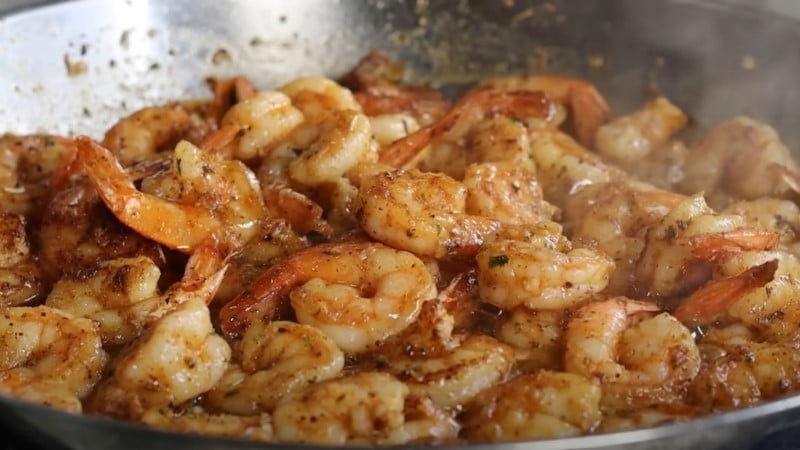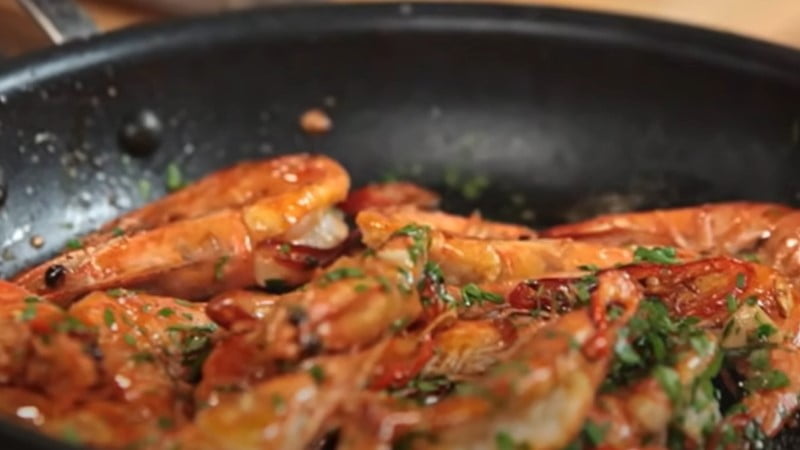The benefits of eating shrimp tails might not be well-known, but they deserve a closer look. Encased in a shell, these tails impart a unique flavor and texture to your dish, enhancing the overall dining experience. They’re rich in chitin, a dietary fiber with associated health benefits.
By incorporating shrimp tails into your diet, you unlock many nutritional benefits of eating shrimp tails, adding a whole new dimension to your culinary adventures.
Nutritional Value Of Eating Shrimp Tails
Contrary to what we might think, the delectable shrimp tail isn’t just a handle or garnish; it’s a nutritional trove. It offers dietary fiber in chitin, assisting digestion and contributing to a balanced diet. But the nutrition story doesn’t stop there. Shrimp tails also serve trace minerals such as calcium and zinc, essential for bone health and immune function. These crispy ends even house astaxanthin, a potent antioxidant that lends the shrimp its characteristic color.
Comparatively, the meat of the shrimp, while a low-fat, high-protein food, doesn’t provide the same level of dietary fiber or the antioxidant astaxanthin. Thus, embracing the benefits of eating shrimp tails enriches your seafood menu, broadening the nutrient scope of your meals while amplifying the advantages gained from consuming the rest of the shrimp.

Health Benefits Of Eating Shrimp Tails And Shells
Shrimp tails don’t just bring a new dimension to the flavor and texture of our meals; this part of the shrimp also contributes to our health in surprising ways.
The dietary fiber in shrimp tails, chitin, plays a significant role in our health. A fiber-rich diet supports digestion, and aids in maintaining a healthy weight, and research suggests that increased fiber intake might be linked to lower occurrences of cardiovascular issues and type 2 diabetes.
Furthermore, the trace minerals in shrimp tails – calcium and zinc – contribute to stronger bones and a more robust immune system. Astaxanthin, the antioxidant found in shrimp tails, has various health benefits, including promoting heart health, supporting the immune system, and demonstrating anti-aging properties.
Remember the benefits of eating shrimp tails next time you enjoy a plate of shrimp. Incorporating them into your diet diversifies your flavor experiences and fortifies your health.
Preparing And Eating Shrimp Tails
Contrary to popular belief, preparing shrimp tails for consumption is not daunting. If you are cooking the shrimp whole, clean it thoroughly and cook it properly to avoid any health issues. The tails can be left on during cooking, becoming crispy and flavorful under the right heat.
Grilling, sautéing, or roasting the shrimp are fantastic methods that lend the tail a delightful crunch. If you’re a fan of deep-fried treats, shrimp tempura is a popular recipe where the whole shrimp, tail included, is dipped in batter and fried to golden perfection. The tail adds a contrasting texture to the tender meat, creating a culinary delight that is both nutritious and delicious.
Another way to include shrimp tails in your diet is through broths or stocks. Shrimp shells and tails are flavorful and can infuse your soup with a rich seafood depth. Simply simmer the shrimp shells and tails in water with your choice of aromatics, strain, and use this broth as a base for your soups, stews, or risottos.

Read more: What To Serve With Shrimp Cocktail?
Misconceptions And Concerns About Eating Shrimp Tails
First off, one common misconception is that shrimp heads and tails are inedible. On the contrary, both parts of the shrimp are not only edible but also add unique flavor and texture to dishes. They are also sources of protein and other essential nutrients. The tails, specifically, are low in calories but high in nutritional value, adding fiber and trace minerals to your meal.
Often, concerns arise about whether our bodies can digest shrimp tails. Just like the shell of the shrimp, the tails contain chitin, a type of dietary fiber. While we don’t digest fiber, it still plays a vital role in our digestive health, helping to regulate bowel movements and contribute to a feeling of fullness.
Some diners worry about the potential taste of shrimp tails. However, tails can enhance the flavor of a dish, offering a seafood essence that complements the main course or serves as an intriguing appetizer.
Shrimp tails are not only a good source of protein, but they also contain omega-3 fatty acids and vitamin B12. So, if you’re comfortable with the texture and you’ve cooked the shrimp properly, feel free to eat the tail.
Benefits Of Eating Shrimp Tails: FAQs
Can you eat the tails of raw shrimp?
Eating uncooked shrimp or its tail is not recommended. Always ensure your shrimp is cooked thoroughly.
Are shrimp tails suitable for children?
Yes, children can eat shrimp tails. However, ensure they chew thoroughly due to the tails’ tougher texture.
What are the potential weight loss benefits of eating shrimp tails?
Due to their chitin content, shrimp tails may contribute to feelings of fullness, potentially assisting in weight loss efforts when consumed as part of a balanced diet.






![What To Pair With Quiche? 25+ Best Dishes [With Pictures]](https://www.edithsbistro.com/wp-content/uploads/2024/04/what-to-pair-with-quiche-160x90.jpg)

Hi Edith! What a beautiful site! Thanks for sharing your research on shrimp! Would you happen to have come across the nutrition facts (the table) for shrimp shells (and tails)? If so, I’d love to see it. Thanks!